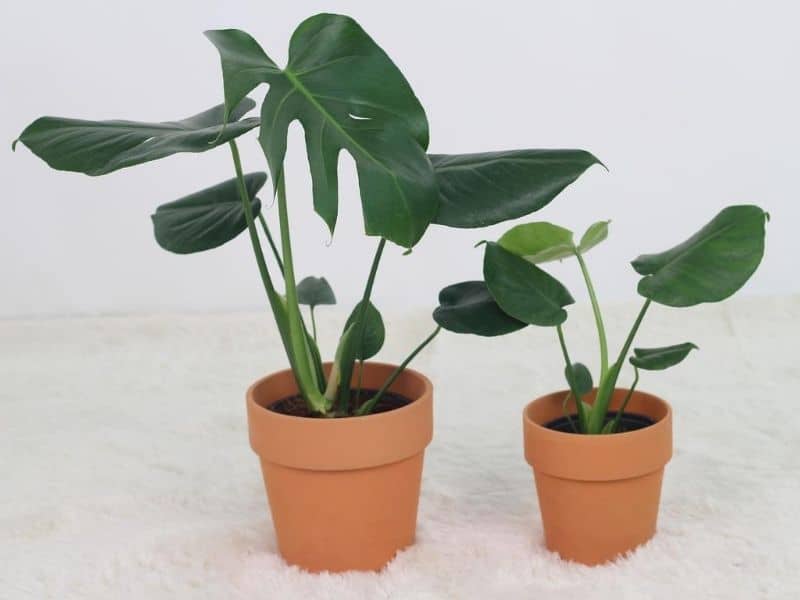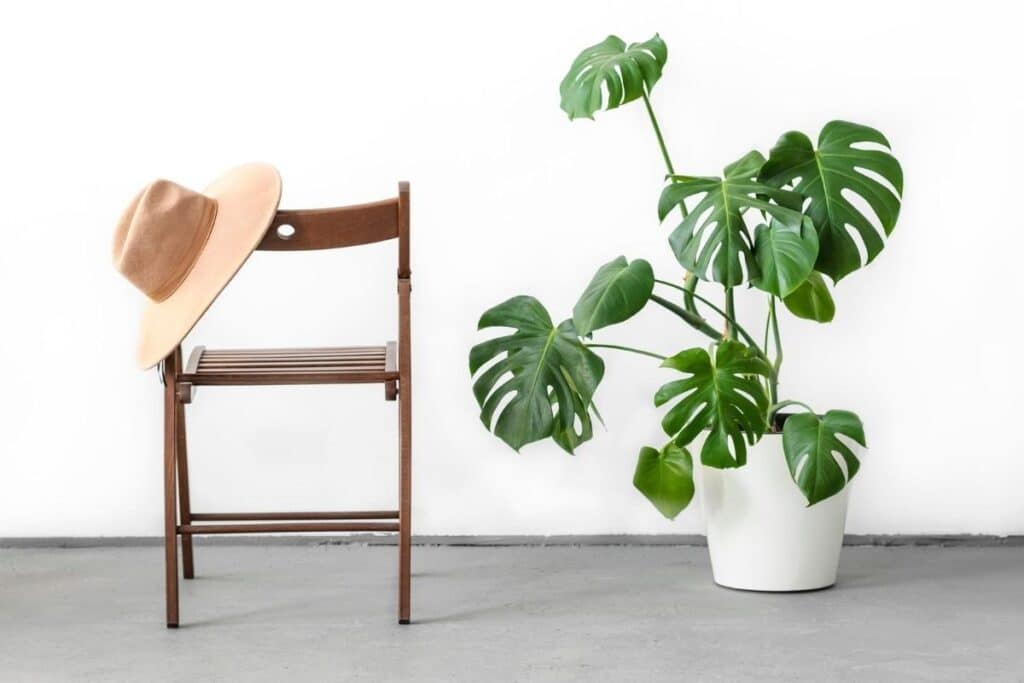House plants used to be small and light since they were usually brought in to already small and limited indoor spaces. However, as people became more enthusiastic about greening the indoors, bigger spaces were allotted for plants.
Plant aesthetics have become part of interior designs and for the modern, trendy gardeners, big-leafed monsteras (such as monstera adansonii) are a must-have.
What is a Monstera?
Monsteras, particularly Monstera deliciosa belong to the Arum family originating from the jungles of South Africa (1). M. deliciosa is also synonymous to Philodendron pertusum since the ornamental foliage closely resembles that of philodendrons’ (2).
It is famous for its dramatic, monstrous leaves that have natural holes on the blade and cuts along the margins, hence the common names Swiss cheese plant and split-leaf philodendron (3).
The perforations on the leaves are actually the plant’s way of dealing with strong winds in the wild (4). These leaves are attached to strong stems that develop aerial roots which the plant uses to gather moisture and to climb trees and poles (2).

What are the uses of the Swiss cheese plant?
Aside from being popular as a houseplant creating an instant tropical, jungle vibe, this monstera is a known medicinal and culinary plant. The pulp from the flower is used to treat skin spots, rough and dry skin, and pimples.
The floral spathe is also used as wound or bruise dressing. The aerial roots can also be fashioned into ropes to create baskets (2).
In the wild, the plant will bloom in its third year and the resulting fruit ripens within a year. The flower heart can be eaten raw, described to taste like guava, pineapple, granadilla, and banana, all at the same time, giving this monstera another name—fruit salad plant.
Toxicity to Pets and Humans
It is important to note that only the fruit of the plant is edible. The leaves, roots, and stem of the plant contain toxic properties that can cause harm to humans and animals.
Throat irritation and inflammation as well as diarrhoea may be experienced so be careful of the placement of this plant indoors (2).
How to Care for Monstera Plants

Light and Water
Monsteras are natural dwellers of tropical rainforests where their leaves grow as big as 70 cm long under the canopies of large trees. This means that they thrive best in diffused sun and semi-shade (1). Although they can stand full sun, prolonged exposure damages the leaves and turns them dull.
They require high moisture conditions but indoors, monsteras will need the soil to dry slightly between watering. Well-draining soil is key for these plants to survive since they cannot stand waterlogging (2).
Temperature and Humidity
Although this plant lives in a humid climate with temperatures ranging from 20 to 30°C, it can withstand up to 10°C but growth will be slower. Like most easy house plants, they should be kept indoors during winter (4).
Pests and Disease
Your Swiss Cheese Plant (Monstera Adansonii) can attract sap-sucking pests like mealybugs and spider mites. Look for sticky spots or webbing on leaves. Treat them with neem oil or insecticidal soap.
Overwatering Monstera deliciosa leads to root rot, showing as mushy stems and yellow leaves. Water only when the top inch of soil dries. Fungal diseases like powdery mildew cause white patches on leaves. Increase air circulation and use fungicide if severe.
Propagation and Maintenance
Propagation of the Swiss cheese plant is often done by stem cutting, particularly when they start outgrowing their container (1). Since the plant is a climber, nodes where aerial roots grow appear on the growing stem and the plant can be cut along the internodes to obtain propagules.
Cuttings can also be placed in jars half-full with water to allow them to produce roots. Some people find it easier to root monsteras by air layering or marcotting too.
Either way, once the propagules have established roots, they should be transplanted close to a tree trunk when outdoors and on a pole or a wall indoors so that they can climb.
Monsteras can grow in most soil mixtures used for most houseplants but for a healthy growth, saline conditions should be avoided. They like well-drained and organic matter-rich substrates (2).
Given that these plants produce aerial roots as they mature, their containers must be large enough to accommodate the growth (4).
Ideally, they should be repotted once every 2 years, during spring, to allow the roots to breathe and to provide nourishment too, aside from the monthly fertilizer application that they require.
Top 8 Monstera Plant Types and Varieties for Indoor Use
1. M. deliciosa
The most popular and star of this article monstera, M. deliciosa bears the iconic big split and holed leaves often featured by interior designers, nurseries, and house plant growers. The plant is dark green and glossy with the new leaves unfurling in light green color.
2. M. deliciosa aurea variegata
This variety features golden or lighter green variegations on the leaves and petioles making it look like giant golden pothos. Brighter light than usual is preferred to keep the variegation of the plant.
3. M. deliciosa albo variegata
A lighter variety, this monstera has white variegation, often overpowering the natural green of the plant. It grows slower and needs brighter light exposure than most monstera types hence more difficult to grow and more expensive.
4. M. adansonii
M. adansonii is the actual Swiss cheese plant of the monsteras. Its heart-shaped leaves get covered in holes like that of a Swiss cheese slice as the plant matures. This attractive foliage can grow as large as 50 cm in the wild but indoors, they remain a manageable size of 20 cm.
5. M. obliqua
Like M. adansonii, the green leaves of this Monstera Obliqua plant are filled with holes; only the perforations on this one are larger and irregular.
6. M. dubia
This type of monstera grows like F. pumila which loves to climb on flat surfaces like walls. The green and silver leaves are attached to the stem producing tiny roots that tightly cling onto walls.
7. M. pinnatipartita
This compact monstera also has split leaves but they are more prominent and wider. The dark green leaves are glossy and defined veins.
8. M. siltepecana
Like M. dubia, this Silver Monstera plant is a mixture of green and silver but on the glossier side. The leaves are also heart-shaped with elongated tips. They climb best and grow bushy on poles.
See more: Rhaphidophora Tetrasperma Plant
References
Reference List
(1) Dey, S. “Growing Shrubs and Climbers”. 2001. Sterling Publishers Pvt. Ltd. P. 144.
(2) Paull, R. & Duarte, O. “Exotic Fruits and Nuts of the New World”. 2015. P. 342.
(3) Davis, J. “Indoor Gardening the Organic Way”. 2006. Traylor Trade Publishing. P. 208.
(4) Pleasant, B. “The Complete Houseplant Survival Manual”. 2012. P. 384.
Close
Image by kseniasol/depositphotos







